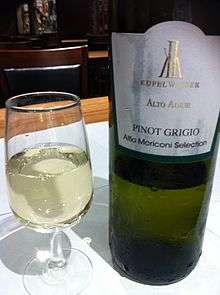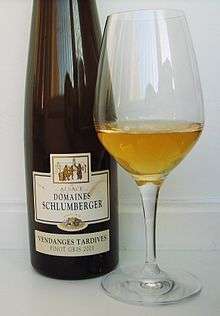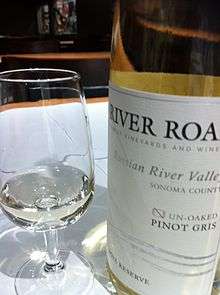Pinot gris
| Pinot gris | |
|---|---|
| Grape (Vitis) | |
|
A bunch of Pinot gris grapes. | |
| Color of berry skin | Rose |
| Species | Vitis vinifera |
| Also called | (see list of synonyms) |
| Origin | Burgundy, France |
| Notable regions | (see major regions) |
| VIVC number | 9275 |
Pinot gris, pinot grigio or Grauburgunder is a white wine grape variety of the species Vitis vinifera. Thought to be a mutant clone of the pinot noir variety, it normally has a grayish-blue fruit, accounting for its name but the grapes can have a brownish pink to black and even white appearance. The word pinot could have been given to it because the grapes grow in small pine cone-shaped clusters. The wines produced from this grape also vary in color from a deep golden yellow to copper and even a light shade of pink,[1] and it is one of the more popular grapes for skin-contact wine.
Pinot gris is grown around the globe with the "spicy" full-bodied Alsatian and lighter-bodied, more acidic Italian styles being most widely recognized. The Alsatian style, often duplicated in New World wine regions such as Marlborough, Tasmania, South Australia, Washington, and Oregon, tend to have moderate to low acidity, higher alcohol levels and an almost "oily" texture that contributes to the full-bodied nature of the wine. The flavors can range from ripe tropical fruit notes of melon and mango to some botrytis-influenced flavors. In Italy, Pinot grigio grapes are often harvested early to retain the refreshing acidity and minimize some of the overt-fruitiness of the variety, creating a more neutral flavor profile. This style is often imitated in other Old World wine regions, such as Germany where the grape is known as Ruländer.[2]
History

Pinot gris has been known since the Middle Ages in the Burgundy region, where it was probably called Fromenteau. It spread from Burgundy, along with Pinot noir, arriving in Switzerland by 1300. The grape was reportedly a favorite of the Emperor Charles IV, who had cuttings imported to Hungary by Cistercian monks: the brothers planted the vines on the slopes of Badacsony bordering Lake Balaton in 1375. The vine soon after developed the name Szürkebarát meaning "grey monk." In 1711, a German merchant, named Johann Seger Ruland (re)discovered a grape growing wild in the fields of the Palatinate. The subsequent wine he produced became known as Ruländer and the vine was later discovered to be Pinot gris.[1]
Until the 18th and 19th century, the grape was a popular planting in Burgundy and Champagne but poor yields and unreliable crops caused the grape to fall out of favor in those areas. The same fate nearly occurred in Germany, but vine breeders in the early 20th century were able to develop clonal varieties that would produce a more consistent and reliable crop.[1]
Researchers at the University of California, Davis, have determined that Pinot gris has a remarkably similar DNA profile to Pinot noir and that the color difference is derived from a genetic mutation that occurred centuries ago. The leaves and the vines of both grapes are so similar that the coloration is the only aspect that differentiates the two.[3]
Around 2005, Pinot gris was enjoying increasing popularity in the marketplace, especially in its Pinot grigio incarnation and similar New World varietal wines.[4]
Regions

The total area cultivated by this vine worldwide is about 15,000 hectares.
- Argentina – San Juan and Mendoza
- Australia – Tasmania, Yarra Valley, Adelaide Hills, Orange, New South Wales, Mornington Peninsula. 2,836 hectares (as of 2008).[5]
- Austria – 300 hectares or 0.6% of the total wine growing area.
- Canada – British Columbia, Ontario
- Chile – Casablanca, Chile
- Czech Republic – Bohemia, Moravia
- France – Burgundy, Loire, Alsace. 2,582 hectares (as of 2007).[6][7]
- Germany – Baden, Palatinate. 5,042 hectares or 4.9% of the wine growing area (as of 31 July 2008).[8]
- Hungary – Badacsony, Mátraalja
- Italy – Roverè della Luna, Trentino
- Luxembourg
- Moldova
- New Zealand (including Waiheke Island) – 1,383 hectares (as of 2008).[9] In 2007, the area was only 1,146 hectares.[10]
- Romania – Constanța County, Jidvei
- Russia – Crimea
- Turkey – Thrace Region, Kırklareli, Arcadia Vineyards
- South Africa
- Slovenia – Primorska, Podravje
- Switzerland – Valais. About 214 hectares (as of 2007).[11]
- United States – Oregon, California, Idaho, Michigan, Arizona, Virginia, New Jersey, and Washington
Alsace

A major grape in Alsace, grown on 13.9% of the region's vineyard surface in 2006,[12] the varietal Pinot-gris d'Alsace is markedly different from Pinot gris found elsewhere. The cool climate of Alsace and warm volcanic soils are particularly well suited for Pinot gris, with its dry autumns allowing plenty of time for the grapes to hang on the vines, often resulting in wines of very powerful flavours.[13]
Pinot gris is one of the so-called noble grapes of Alsace, along with Riesling, Gewürztraminer, and Muscat, which may be used for varietal Alsace Grand Cru AOC and the late harvest wines Vendange Tardive and Sélection de Grains Nobles.[14]
Previously, the Pinot gris wines produced in Alsace were originally labeled Tokay d'Alsace. In the Middle Ages, the grape was popularized in the region by Hungarian traders who were introduced to the grape from Burgundy. During this time, Tokaji was one of the most popular and sought after wines on the market and the name was probably used to gain more prestige for the Alsatian wine. Pinot gris was believed to have been brought back to Alsace by General Lazarus von Schwendi after his campaign against the Turks in the 16th century. It was planted in Kientzheim under the name "Tokay".[15] However, the Pinot gris grape has no known genetic relations to the Furmint, Hárslevelű, Yellow Muscat and Orémus grapes that are traditionally used in Tokaji wine.[16] In 1980, the European Economic Community passed regulations related to Protected designations of origin (PDOs), and when Hungary started negotiations for European Union membership, it became clear that the Tokay name would have to become a PDO for the Tokaj-Hegyalja region.[17] Therefore, in 1993, an agreement was reached between the Hungary and the European Union to phase out the name Tokay from non-Hungarian wine. In the case of Alsace, Tokay Pinot Gris was adopted as an intermediate step, with the "Tokay" part to be eliminated in 2007.[15][18][19] Many producers had implemented the change to plain Pinot Gris on their labels by the early 2000s, several years before the deadline.
Australia
Pinot gris was first introduced into Australia in 1832 in the collection of grapes brought by James Busby.[20] In Victoria, wines from the grape are labeled both Pinot gris and Pinot grigio, depending on the sweetness of wine with the drier wines being labeled Pinot grigio.[21]
Germany
Grauburgunder cultivation in Germany is divided by wine-growing area as follows:
| Wine region | Vineyards (hectares) |
|---|---|
| Ahr | 3 |
| Baden | 1,636 |
| Franken | 48 |
| Hessische Bergstraße | 38 |
| Mittelrhein | 3 |
| Moselle | 79 |
| Nahe | 210 |
| Palatinate | 1,044 |
| Rheingau | 19 |
| Rheinhessen | 1,153 |
| Saale-Unstrut | 30 |
| Saxony | 41 |
| Stargader Land | - |
| Württemberg | 105 |
| Total for Germany in 2007 | 4,413 |
Source: Vine area statistics, 13 March 2008, Statistisches Bundesamt, Wiesbaden 2008 in Beschreibende Sortenliste des Bundessortenamtes 2008, pages 198ff.[22]
Italy

In Italy, where the grape is known as Pinot grigio, plantings can be found in the Lombardy region around Oltrepo Pavese[23] and in Alto Adige, Italy's northernmost wine region.[24] The grape is also prominent in the Friuli-Venezia Giulia region.[25]
New Zealand
Pinot gris is grown in both the North, Waiheke Island (Hawkes Bay, Gisborne) and South Islands (Central Otago, Nelson, Marlborough, Waipara), with 1,501 Ha producing as of 2009. This is over a 100% increase since 2006.[26] In 2007, Pinot Gris overtook Riesling as the third most planted white variety after Sauvignon blanc and Chardonnay. Half of all plantings are in Canterbury and Marlborough, with the wine developing a "rich, flinty, fruit-laden character".[27]
Russia
In Russia the grape is known as Пиньо Гри [piˈnɔ ˈɡri]. It is grown in Gurzuf and Ay-Danyl in Crimea on the northern coast of the Black Sea since 1888.[28]
Oregon, California and smaller regions

David Lett, from Eyrie Vineyards, planted the first American Pinot gris vines in Oregon in 1965. Hoping to increase sales, Lett started to graft Riesling vines to Pinot gris in 1979.[29] The grape originally had difficulties finding a sustainable market until Lett began marketing the wine to salmon traders as a good match to the fish. The wine's popularity still only increased slightly until the mid-1990s when well capitalized larger producers entered the picture with enough volume to warrant expensive marketing campaigns.[3] In 1991, King Estate Winery was founded with a mission to produce enough high quality Oregon Pinot gris to develop a sustainable national market for the wine; they are credited with bringing the Pinot gris grape varietal into national consciousness in the U.S.[30] Today they are the world's leading producer of premium Pinot gris and farm the world's largest contiguous organic vineyard which contains over 300 acres (1.2 km2) of Pinot gris grapes.[31]
There are about 1,620 acres (660 ha) planted in the Central and South coastal areas of California.[32] The Pinot gris from California is often called Pinot grigio because of its similarity in style to the wine of Italy.[33]
Pinot Gris can be found in the northern regions of Ohio which is considered part of the pinot trail.
Viticulture
The grape grows best in cool climates, and matures relatively early with high sugar levels. This can lead to either a sweeter wine, or, if fermented to dryness, a wine high in alcohol. Clusters of Pinot gris may have a variety of colors in the vine. These clusters can range from bluish grey to light pinkish brown.[32] The grapes grow in small clusters (hence the pinecone name), and upon ripening, often display a pinkish-gray hue, although the colors can vary from blue-gray to pinkish-brown. Pinot gris is often blended with Pinot noir to enrich and lighten the Pinot noir's flavor.[34]
Wine characteristics
Wines made from the Pinot gris vary greatly and are dependent on the region and wine making style they are from. Alsatian Pinot gris are medium to full bodied wines with a rich, somewhat floral bouquet. They tend to be spicy in comparisons with other Pinot gris. While most Pinot gris are meant to be consumed early, Alsatian Pinot gris can age well.[35] German Pinot gris are more full-bodied with a balance of acidity and slight sweetness. In Oregon the wines are medium bodied with a yellow to copper-pink color and aromas of pear, apple, and/or melon. In California, the Pinot gris are more light bodied with a crisp, refreshing taste with some pepper and arugula notes. The Pinot grigio style of Italy is a light-bodied, often lean wine that is light in color with sometimes spritzy flavors that can be crisp and acidic.[36]
Pinot gris is considered an "early to market wine" that can be bottled and out on the market within 4–12 weeks after fermentation.[37]
Synonyms
Pinot gris is called by many names in different parts of the world:
| Synonym of Pinot gris | Country / Region |
|---|---|
| Auxerrois gris | |
| Fauvet | |
| Fromentau / Fromentot | |
| Grauburgunder / Grauer Burgunder | |
| Grauer Mönch | |
| Grauklevner | |
| Gris cordelier | |
| Malvoisie | |
| Monemvasia | |
| Pinot grigio | |
| Pinot beurot | |
| Ruländer | |
| Rulandské šedé | |
| Sivi pinot | |
| Szürkebarát | |
| Tokay d'Alsace | |
| Піно ґрі, Піно сірий | |
| Пино гриджо | |
| 灰皮诺 |
See also
References
- 1 2 3 J. Robinson Vines Grapes & Wines pg 158 Mitchell Beazley 1986 ISBN 1-85732-999-6
- ↑ Wine & Spirits Education Trust "Wine and Spirits: Understanding Wine Quality" pgs 6-9, Second Revised Edition (2012), London, ISBN 9781905819157
- 1 2 K. MacNeil The Wine Bible pg 745 Workman Publishing 2001 ISBN 1-56305-434-5
- ↑ Wine Business Insider Pinot grigio and Pinot gris Poised to Overtake White Zinfandel 10/10/2005
- ↑ "Areas of vines and grape production by variety – 2007–08". Annual Report 2008–2009. Australian Wine and Brandy Corporation. 2009. p. 89. Retrieved 2014-11-25.
- ↑ LES CEPAGES NOIRS DANS LE VIGNOBLE (pdf), Statistics on red wine varieties per major region, part 1, publication by ONIVINS, 2008
- ↑ LES CEPAGES NOIRS DANS LE VIGNOBLE (PDF), Statistics on red wine varieties per major region, part 2, publication by ONIVINS, 2008.
- ↑ Deutsches Weininstitut (in German), Statistik 2013/2014, Mainz
- ↑ "New Zealand Winegrowers Statistical annual 2008" (PDF). Archived from the original on 15 May 2010. Retrieved 2015-08-12. (PDF; 3,12 MB)
- ↑ "New Zealand Winegrowers Statistical annual 2007" (PDF). Archived from the original on 18 October 2008. Retrieved 2008-07-22. (PDF; 375 kB)
- ↑ Das Weinjahr 2008 (PDF), published by the Office fédéral de l'agriculture OFAG
- ↑ CIVA website, read on September 9, 2007
- ↑ Oz Clarke Encyclopedia of Grapes pg 172 Harcourt Books 2001 ISBN 0-15-100714-4
- ↑ H. Johnson & J. Robinson The World Atlas of Wine pg 124 Mitchell Beazley Publishing 2005 ISBN 1-84000-332-4
- 1 2 Jancis Robinson, ed. (2006). "Tokay d'Alsace". Oxford Companion to Wine (Third ed.). Oxford: Oxford University Press. p. 701. ISBN 0-19-860990-6.
- ↑ K. MacNeil The Wine Bible pg 595 Workman Publishing 2001 ISBN 1-56305-434-5
- ↑ K. MacNeil The Wine Bible pg 284 Workman Publishing 2001 ISBN 1-56305-434-5
- ↑ Jancis Robinson, ed. (2006). "Alsace". Oxford Companion to Wine (Third ed.). Oxford: Oxford University Press. p. 16. ISBN 0-19-860990-6.
- ↑ Decanter October 11, 2006: Italians lament the end of Tocai
- ↑ Queensland Tourism,The World Atlas of Wine Fair Trade and Wine Industry Development. "Pinot gris". Archived from the original on 2007-04-09.
- ↑ H. Johnson & J. Robinson pg. 307 Mitchell Beazley Publishing 2005 ISBN 1-84000-332-4
- ↑ Beschreibende Sortenliste des Bundessortenamtes 2008(pdf; 507 kB)
- ↑ H. Johnson & J. Robinson The World Atlas of Wine pg 156 Mitchell Beazley Publishing 2005 ISBN 1-84000-332-4
- ↑ H. Johnson & J. Robinson The World Atlas of Wine pg 167 Mitchell Beazley Publishing 2005 ISBN 1-84000-332-4
- ↑ H. Johnson & J. Robinson The World Atlas of Wine pg 171 Mitchell Beazley Publishing 2005 ISBN 1-84000-332-4
- ↑ NZ Wine Institute Planted Area Statistics Archived 2007-03-31 at the Wayback Machine.
- ↑ NZ Wine Institute Aromatics Information Archived 2006-11-16 at the Wayback Machine.
- ↑ Pinot Gris Ay-Danyl Archived 2010-07-19 at the Wayback Machine.
- ↑ T. Pinney. A History of WIne in America: From Prohibition to the Present, p. 328 (2005) ISBN 0-520-24176-2
- ↑ Comiskey, P. "Oregon Pinot Gris Puts Some Flash in the Glass," Los Angeles Times, February 6, 2008.
- ↑ Goode, Jamie "Oregon Wine Country," The Wine Anorak, July 30, 2008.
- 1 2 Professional Friends of Wine: Pinot Grigio.
- ↑ Pinot Gris - The Other White Wine
- ↑ Pinot Gris and Pinot Grigio
- ↑ Rosen, Jennifer (June 24, 2009). "Why Am I Drinking Pinot Grigio, or is it Pinot Gris?". Wine: Features. Novus Vinum. Retrieved July 14, 2011.
- ↑ K. MacNeil The Wine Bible pg 60-61 Workman Publishing 2001 ISBN 1-56305-434-5
- ↑ A. Crowe Making Great Early-to-Market White Wines Wine Business Monthly, 02/15/2007